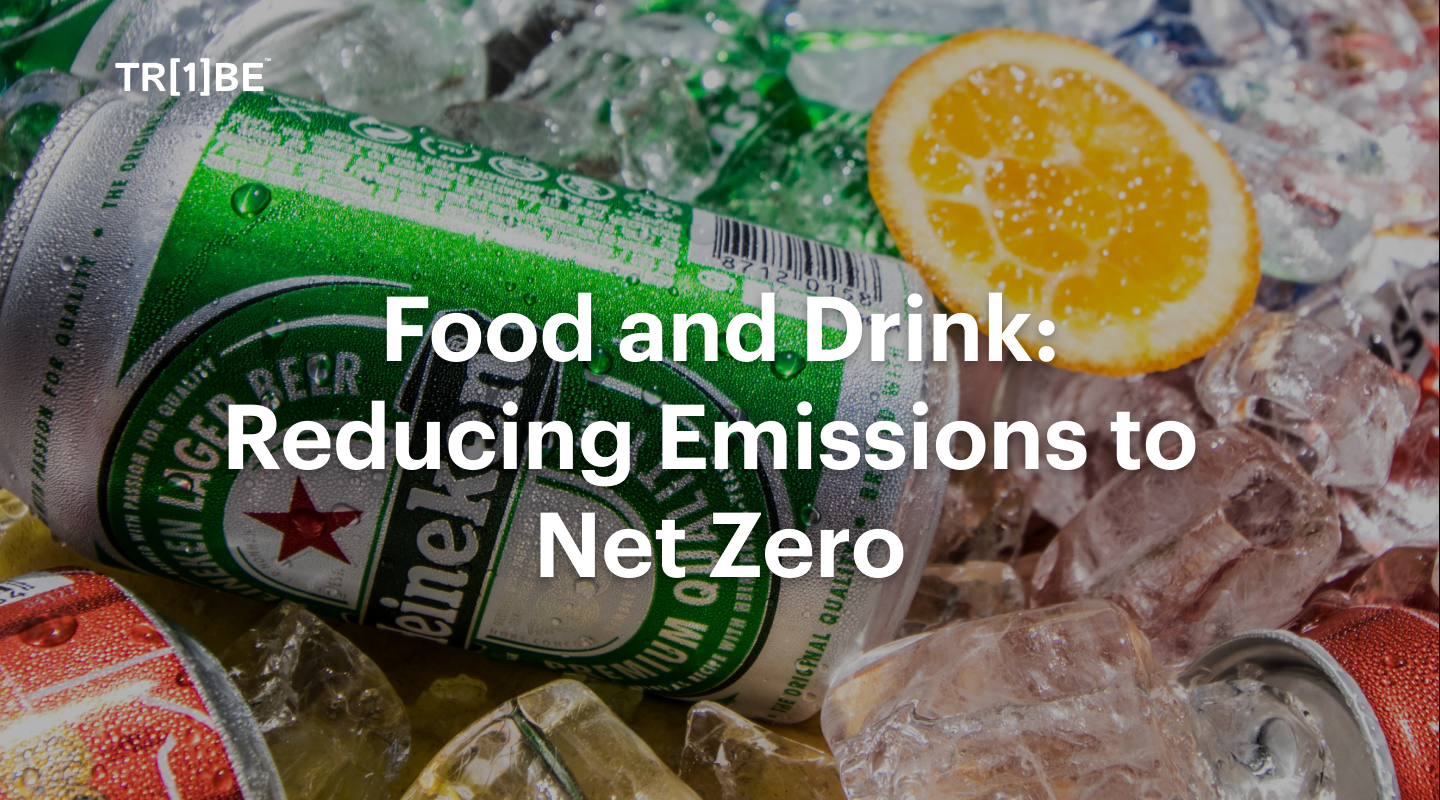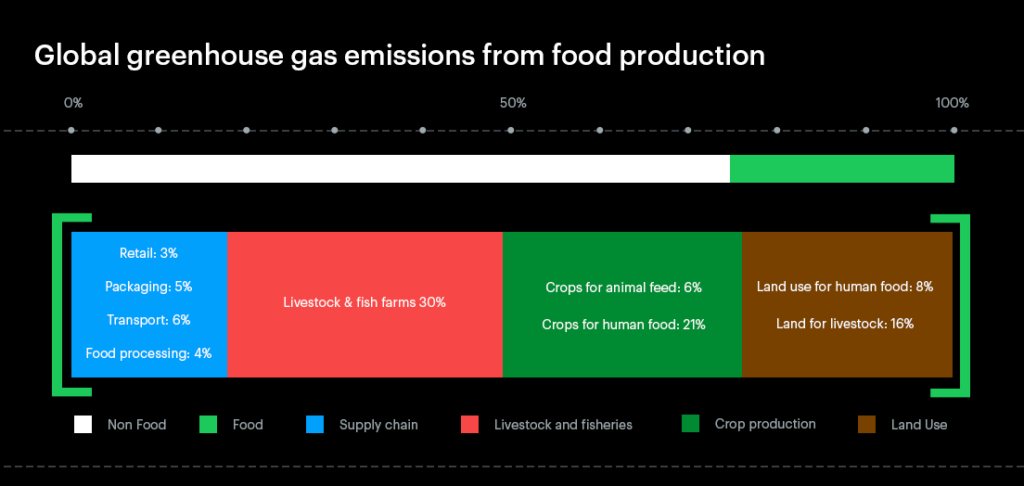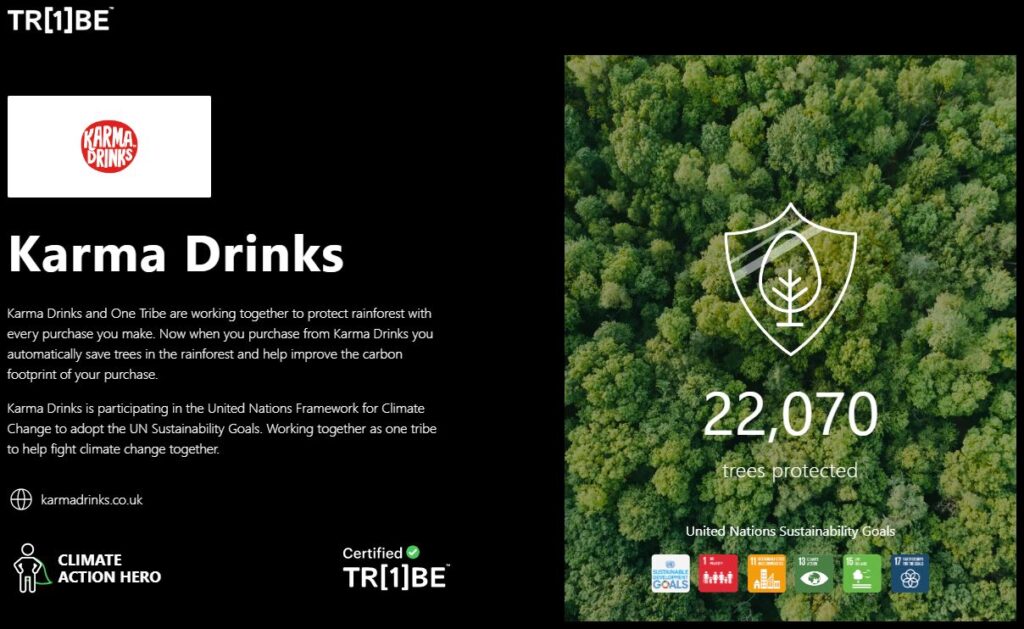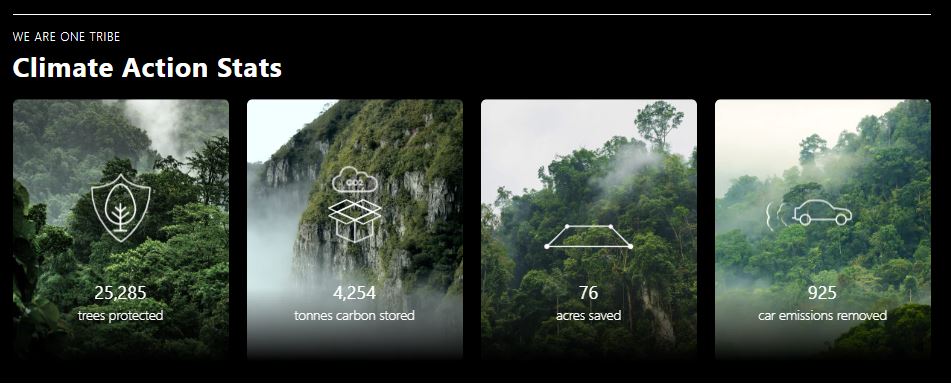
Food is one of our most essential resources that requires a huge amount of land and energy to grow, prepare, and deliver to our tables. Around 33% of global carbon emissions come from food systems, including agriculture and it’s now becoming critical for food and beverage companies to play a more prominent role in reducing emissions and reaching net zero.
In this article, we’ll explore how different sectors of the food industry — from agriculture, to manufacturing, to retailers, can transform their operations, reduce emissions and work with effective carbon offsetting solutions that will achieve net zero goals and help reverse the climate crisis.
Animals bred for meat, dairy, eggs and seafood are one of the largest contributors to the emissions problem surrounding the food and beverage industry. Cattle, as an example, produce the greenhouse gas methane, adding excessive volumes of methane to the atmosphere.
Any on-farm activity, whether it be cattle management or manure management on land or fuel consumption from fishing vessels at sea, is a contributing factor to the increased spike in global emissions.
With an increase in animal husbandry comes an increase in crops to feed said animals. Food production emissions for human consumption already has a large footprint of its own and together with crop production for animal feed, the impact on the planet is a growing concern.
Serving no purpose other than to feed livestock bred for food production, the process of homing and maintaining livestock means emissions are created as a direct result of agricultural production. Variable emissions including the release of nitrous oxide from fertilisers and manure, methane from rice, and carbon dioxide from agricultural machinery are all factors contributing to a much larger, global problem. This is just for the crops needed to feed animals and does not even include the actual land they stand on.
Land use and mass deforestation to make room for agriculture, water-intensive crops and livestock is perhaps one of the most problematic issues surrounding the food and drinks industry. Twice as many emissions result from land use for livestock than as for crops for human consumption.
Farms require space. And needing space for human crops, animal crops, and the animals themselves requires an ever growing amount of farmland. This type of agricultural expansion means more and more forests need to be cut down to make room for livestock and on-site farm operations. The result is an increase of carbon emissions and a destruction of our natural ecosystems.
Cutting down trees alone increases the amount of carbon released back into the atmosphere and also prevents these same trees from sequestering carbon dioxide from the atmosphere. This creates a huge imbalance where we are not only releasing vast amounts of emissions into the atmosphere but we are also removing A grade carbon sinks that have the power to offset those emissions. Effectively doubling the amount of harmful emissions released.
Food processing, from converting produce from the farm to its final product, is just part of the supply chain process in food and drinks manufacturing. Product manufacturing, transport, packaging, and retail all require energy and resources to deliver the final product to a consumer.
Many assume that eating local food is the key to a low-carbon diet, however, transport emissions are often a very small percentage of food’s total emissions. That is, compared to the agriculture and land use elements. With supply chains consisting of so many processes, each with a carbon footprint of their own, it’s essential that we reduce emissions by evaluating and improving the sustainability of the supply chain process itself.
Reducing emissions from food production will be one of our greatest challenges in the coming decades. Unlike many aspects of energy production, where viable opportunities for upscaling low-carbon energy, renewable or nuclear energy, are available, the ways in which we can decarbonise agriculture are less clear. We need inputs such as fertilisers to meet growing food demands, and we can’t stop cattle from producing methane. We will need a menu of solutions: changes to diets; food waste reduction; improvements in agricultural efficiency; and technologies that make low-carbon food alternatives scalable and affordable.
Food waste emissions are extreme by comparison to that of the supply chain. One-quarter of emissions (3.3 billion tonnes of CO2eq) from food production ends up as food waste. Either from supply chain losses or consumers’ individual habits to throw away unused food and drink products. Durable packaging, refrigeration and food processing can all help to prevent food waste.
While these factors aren’t entirely avoidable, companies can improve processes to reduce emissions. Additionally, reducing emissions isn’t the only way food and beverage companies can reduce their footprints.foo

What’s unavoidable is that food needs to be planted, packaged and transported. This will always require energy and land. While that energy should be clean and renewable and that land should be sourced without deforestation, if those aren’t options for your company, then it’s time to consider offsetting solutions.
Even if you’re not sure of your company’s carbon footprint, calculating it shouldn’t be too hard. Not only are there companies dedicated to the practice and a reliable certification system for doing so, but the UK government also provides carbon calculation guides for businesses large and small.
Once you’re aware of your carbon footprint and have a strategic plan in place to reduce as many emissions as possible, you can then start considering carbon offsets. Carbon offsetting is the process of directly removing carbon from the atmosphere or contributing financially to those efforts. These efforts usually involve planting or protecting carbon-efficient trees that draw and sequester carbon from the atmosphere. However, the crucial factor to consider when buying offsets is not the method but the seller’s reliability.
One Tribe Global offers a carbon offset marketplace that enables the secure purchase of certified carbon credits from projects following environmental and ethical best practices. If you’re a manufacturer, farmer or other top-of-funnel producer of food and beverages, this may be your best option for reducing carbon emissions. In fact, One Tribe already has a list of food manufacturers and drinks brands successfully reducing emissions via offsets.
However, if you’re conducting a high volume of transactions, there are other offset methods you can use to maximise your environmental benefit. For retailers or DTC food and drinks brands, you should consider building offsets into your purchase process. Rather than buying an upfront, fixed carbon offset, you can build it into your retail process using a partner (like One Tribe) with access to climate action tools.
How does it work? These tools allow you to set up your sales channels so that a small percentage of every transaction goes to financially supporting carbon offsets, which automatically scales your business,and therefore your emissions, to your total carbon offsets. Not only will this provide an economically efficient means of calculating and distributing your financial contribution but it unlocks marketing potential related to each purchase’s impact.

Consider One Tribe partner brand Karma Drinks, not only are they able to use the statistics on their Climate Action page in marketing campaigns, but they can show each individual buyer what the impact of their purchase is. This is useful for both a direct sales organisation and retail partners alike in their efforts to sell more sustainably.

Of course, the best method for reducing carbon emissions is not producing them in the first place. For food and beverage companies, there are a lot of ways to achieve this. A great way to achieve this is by creating and selling more sustainable food and beverages. How can this be achieved?
First, consider the ingredients you use in your product. Do you rely on meat or animal-based products when you don’t need to? Are you using carbon-intensive crops like rice when there are other options? Next, consider the supply chain of your products. Can you transform your own supply chain to be more efficient or work with a more sustainable partner for a comparable cost? The truth is that cost shouldn’t be the only factor in determining which raw materials go into your product and how it’s transported. As the climate crisis intensifies, the human and economic cost of carbon emissions must be factored in too.
However, even from the cost angle, the outlook is good. Not only are 77 percent of consumers convinced climate action must be taken (and especially by businesses), but up to 33% are willing to pay more for sustainable goods, according to Deloitte UK. So, there isn’t just a moral mandate to transform your food and drinks business, but an economic one as well.
Reaching net zero likely won’t take as long as you expect, but for businesses in the food and drinks space, it can be greatly sped up by purchasing carbon offsets. However, reductions in energy usage and a pivot toward sustainable products are the foundation of any environmental strategy.
What are carbon offsets?, how are carbon offsets used?, race to Net Zero, Net Zero, carbon offset market, what is the carbon offset market?, Paris Agreement, what is the Paris Agreement?, what does the Paris Agreement say?, what is the Paris Agreement for?, how to stop the Earth’s temperature rise?, how to stop climate change?, Net Zero infrastructure, what is Net Zero infrastructure?, how to reduce greenhouse gas emissions?, how to make my business sustainable?, what do businesses do to be sustainable? how do I measure my carbon emissions?, nature-based solutions, forest conservation, ocean conservation, sustainable technology solutions, renewable energy, hydropower, what is carbon neutral?, how to measure my carbon footprint?, carbon footprint calculation tools, which tools calculate carbon footprint?, how does carbon offsetting work?, carbon offsetting schemes, what is a carbon offsetting scheme?, example carbon offsetting schemes?, What are companies using carbon offsets for?
One Tribe is a Climate Action Platform enabling businesses and their customers to make a positive environmental impact.
Eric currently works as an independent consultant at the intersection of nature and climate, focused on catalysing market and non-market solutions to drive the just transition.
He previously was Head of Product at Earthshot Labs, supporting nature conservation and restoration projects across the global south secure project finance. Prior to Earthshot Labs, Eric led nature-based carbon project development for Gorongosa National Park in Mozambique and founded the Carbon Cooperative, a global alliance of leading nature conservation and restoration practitioners exploring carbon finance. After serving in the Peace Corps in Mozambique out of university, he spent much of his 20s working in community-based conservation and ecosystem restoration efforts in Sub-Saharan Africa interspersed with two startup ventures as co-founder and CEO of a mental health tech startup and COO of a sustainable coffee company. Eric has a dual Masters in Environmental Engineering and Environmental Policy from Stanford University where he was a NSF Graduate Research Fellow and a BS in Environmental Engineering from Tufts University.
Alan is a risk management thought-leader, superconnector, and FinTech pioneer. His mission is to enable an Earth Positive economy which includes nature in global accounting systems.
Alan is Founder of Generation Blue, a venture studio dedicated to planetary game changers powered by exponential technologies. Previously, Alan established Natural Capital Markets at Lykke AG, pioneering blockchain based forestry and carbon backed tokens. Alan has over two decades of risk management experience advising global financial institutions, and was a founding member of the RiskMetrics Group, a JPMorgan spin-off. Alan is an investor and advisor to regenerative impact ventures, including TreeBuddy.Earth, Regenativ, and Vlinder Climate.
Lori Whitecalf made history when she became the first woman to be elected Chief of Sweetgrass First Nation in 2011. She served three terms of office from 2011-2017.
Lori took a two-year hiatus from leadership to expand the family ranch and serve as the FSIN Senior Industry Liaison. She was re-elected on November 29. 2019 and again on November 30, 2021, as Chief of Sweetgrass. Chief Whitecalf practises a traditional lifestyle of hunting, fishing and gathering. She currently sits on the following boards: Saskatchewan Indian Institute of Technology, FSIN Lands and Resource Commission, Battle River Treaty 6 Health Centre and Battleford Agency Tribal Chiefs Executive Council, FSIN Women’s Commission.
Tina is the Chief Business Officer for MLTC Industrial Investments, the Economic Development arm of the Meadow Lake Tribal Council. She has a diverse background of experience. Having spent 15 years as a municipal Chief Operating Officer, 20 years involved in Saskatchewan’s Health Authority Board Keewatin Yatthe and 9 years with Northern Lights Board of Education.
She continues as a Board Member with Beaver River Community Futures supporting small business development in her home region. Tina brings a wealth of experience in a variety of fields and many connections to the Indigenous communities of Northern Saskatchewan. In addition Tina holds a BA Advanced from the U of S, a Certificate in Local Government Authority from the U of R and is certified as a Professional Economic Developer for Saskatchewan and a certified Technician Aboriginal Economic Developer (TAED).
Tootoosis’ career spans 40+ years in HRM, political leadership, and Indigenous economic development, as a dedicated bridge builder and advocate for Indigenous causes.
As a key member of the Saskatoon Regional Economic Development Authority (SREDA) team since 2021, he develops strategies for the Truth and Reconciliation Commission final report and Call to Action #92.
He is a graduate of the First Nations University of Canada and a certified Professional Aboriginal Economic Developer. Spearheading various community initiatives while serving as a Chair of the SIEDN while directing ILDII and WIBF. Founder of MGT Consulting Tootoosis is based in Saskatoon, Treaty Six Territory.
Cy Standing (Wakanya Najin in Dakota) has a long and distinguished career including serving overseas as an Electronics Technician in the Royal Canadian Air Force, former Chief of Wahpeton Dakota Nation, former Vice Chief of the Federation of Saskatchewan Indigenous Nations (FSIN), past Executive Director of Community Development Branch of the Department of Northern Saskatchewan as well as an Order in Council appointment to the Federal Parole Board.
Mr. Standing has served as a Director on many Profit and Non-Profit Corporate Boards, including serving as a Director for Affinity Credit Union with assets of over six billion dollars as well as IMI Brokerage and Wanuskewin and is currently a member of the One Tribe Indigenous Carbon Board.